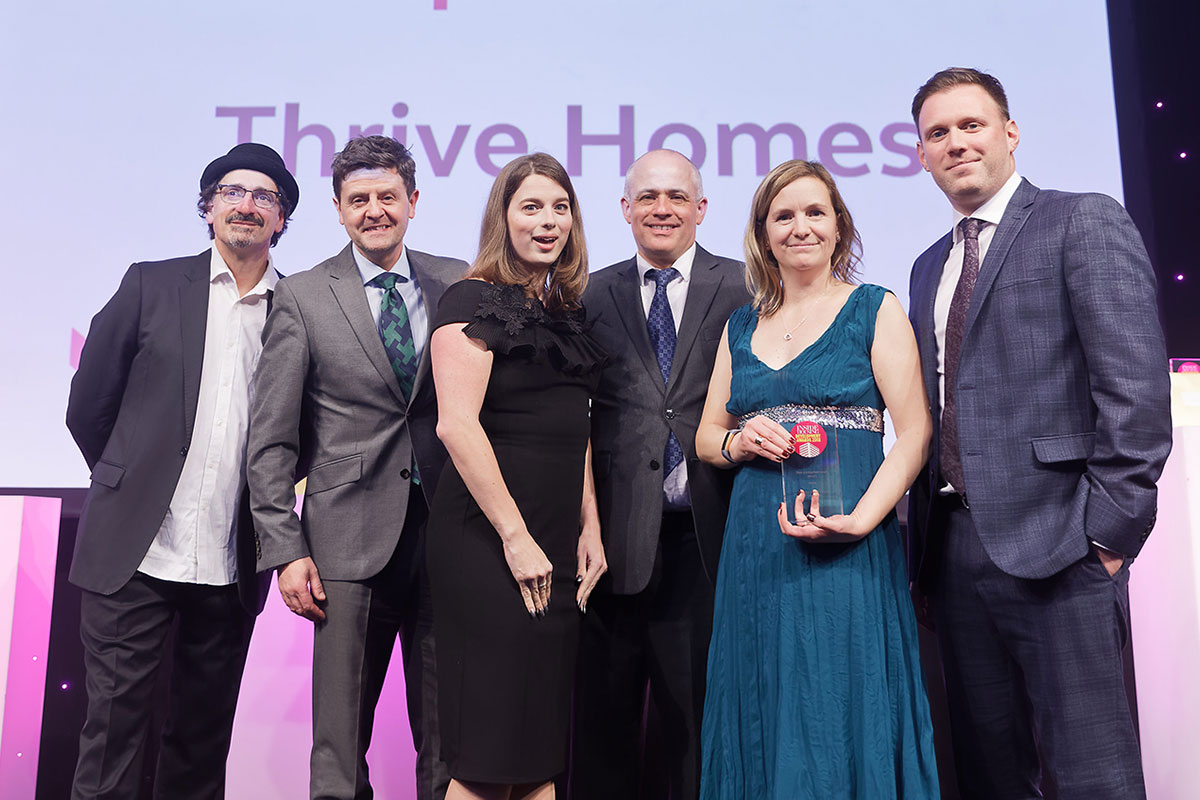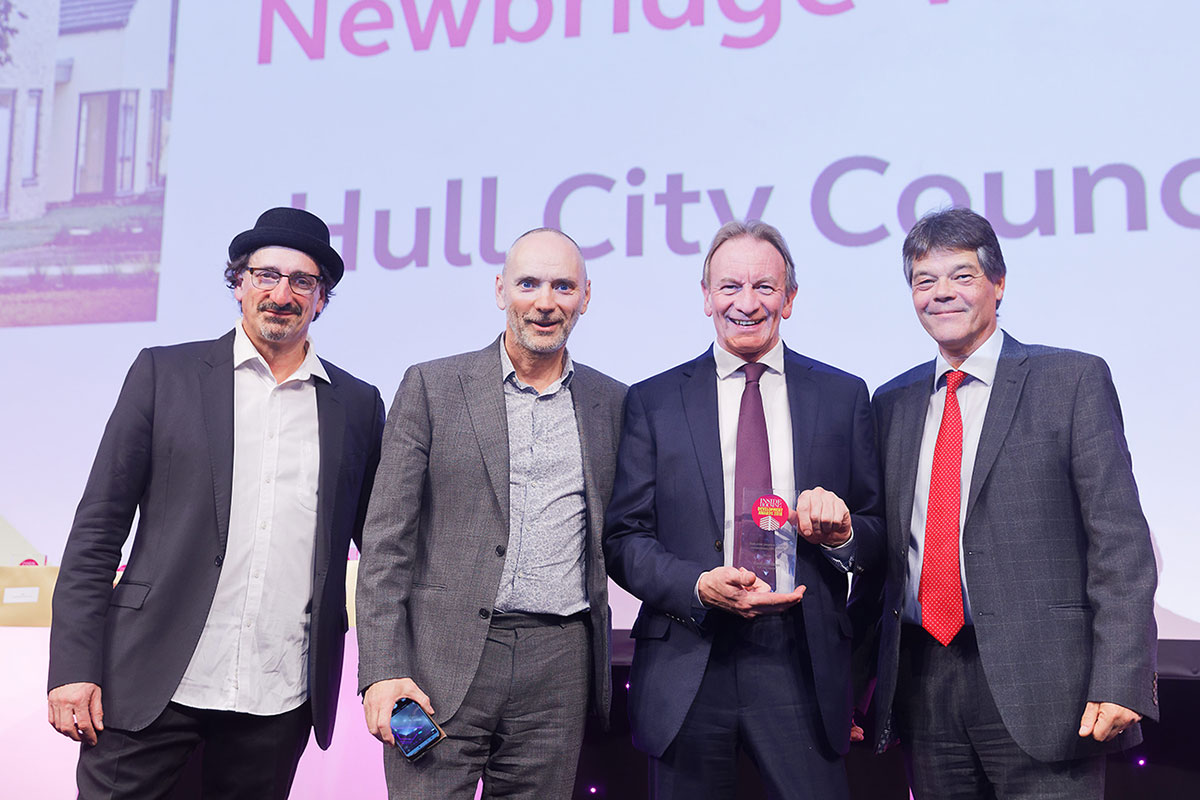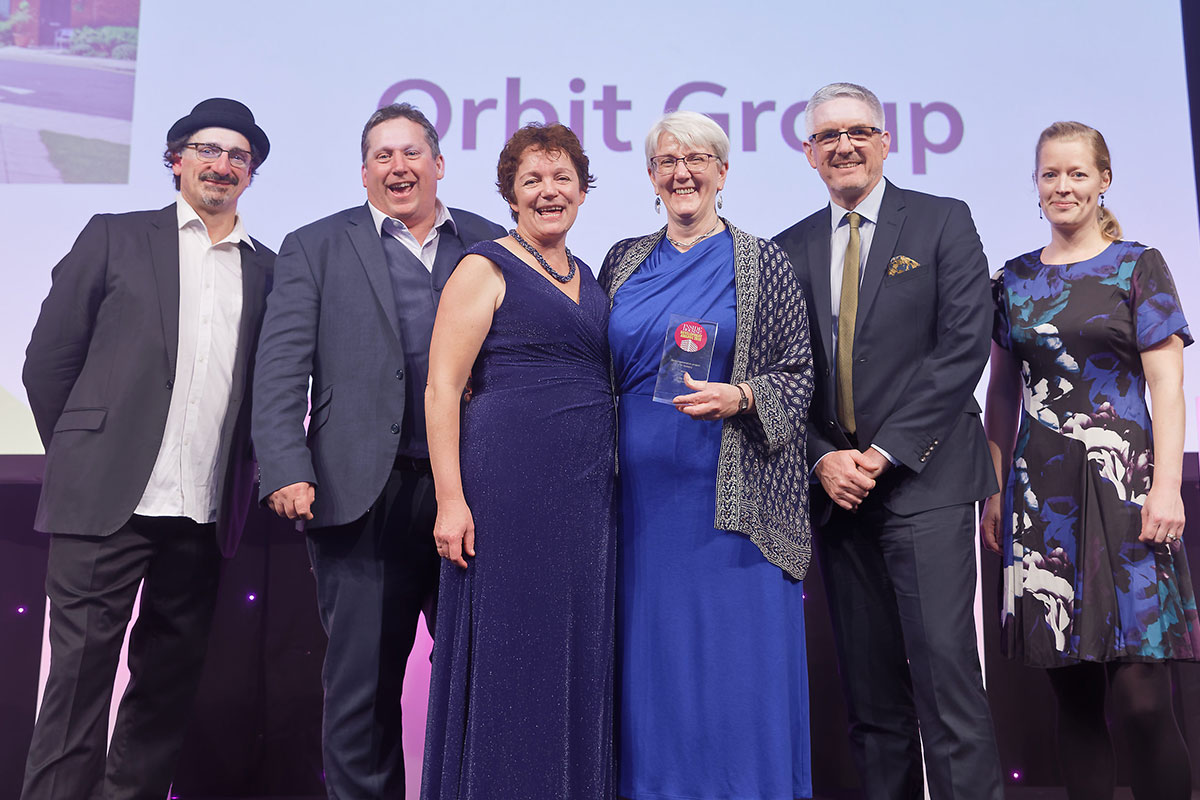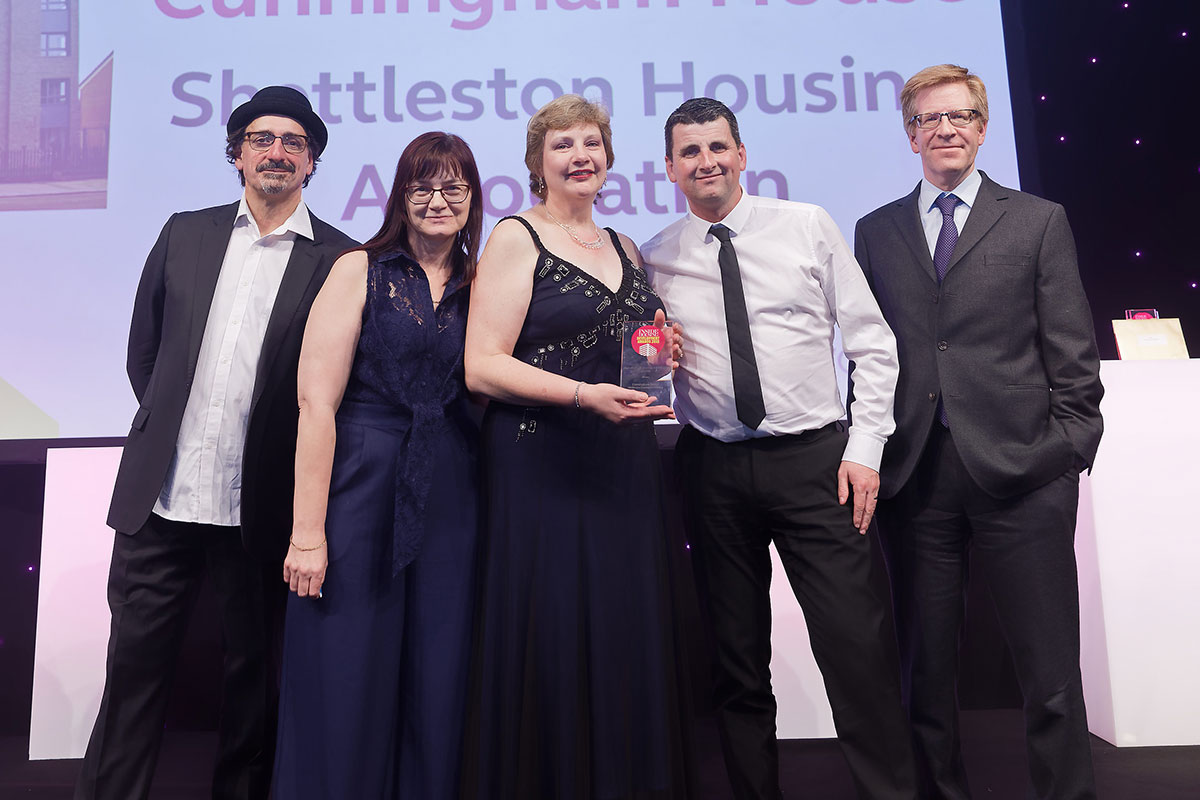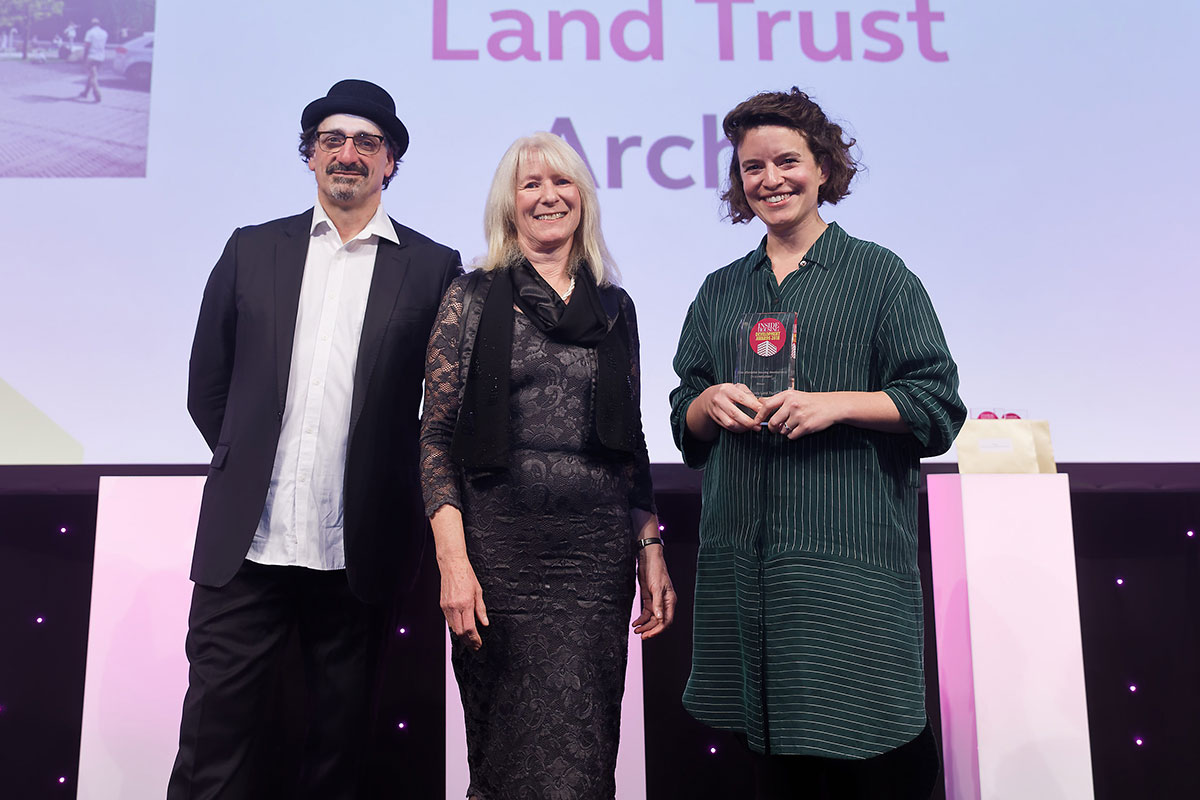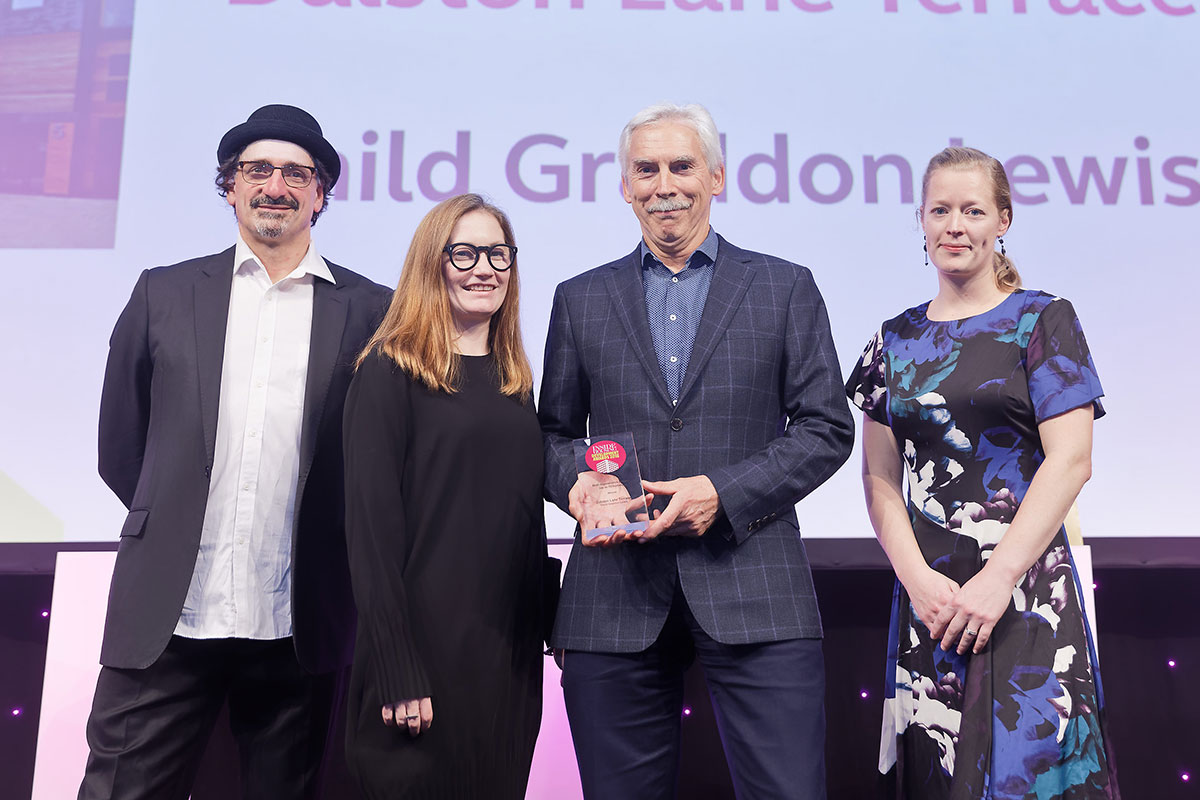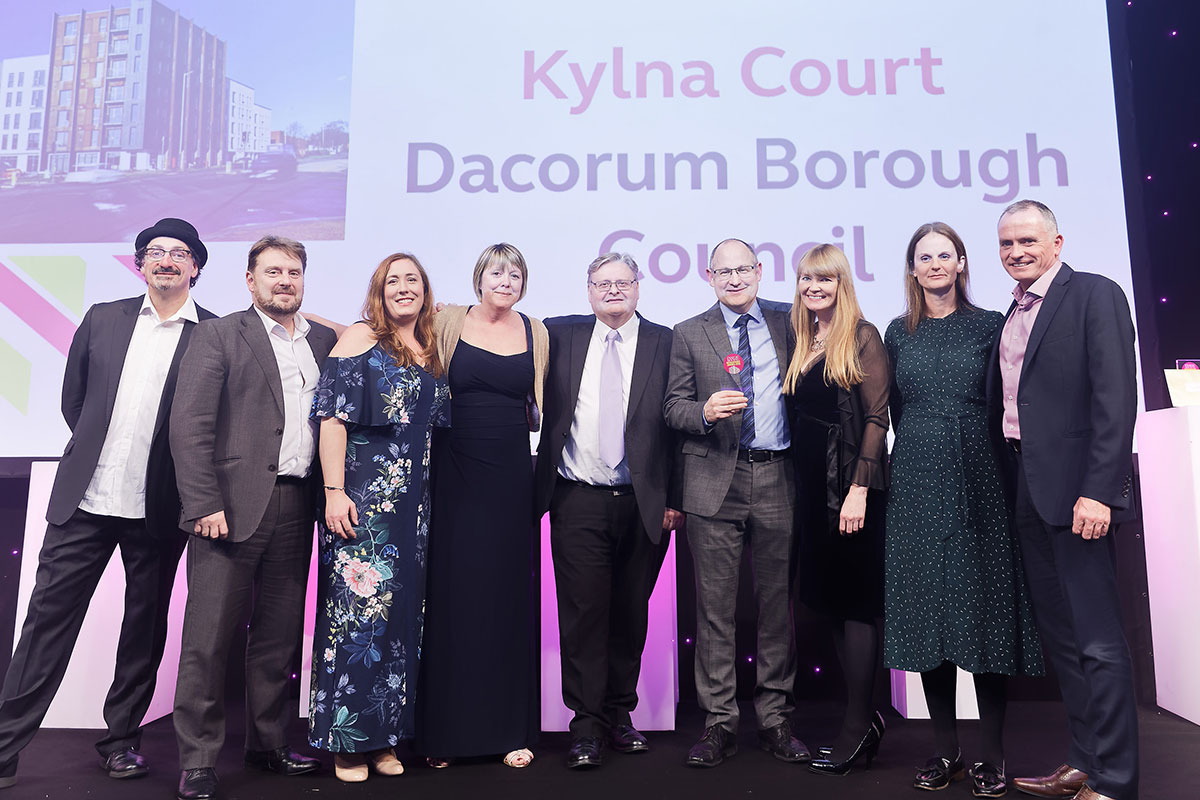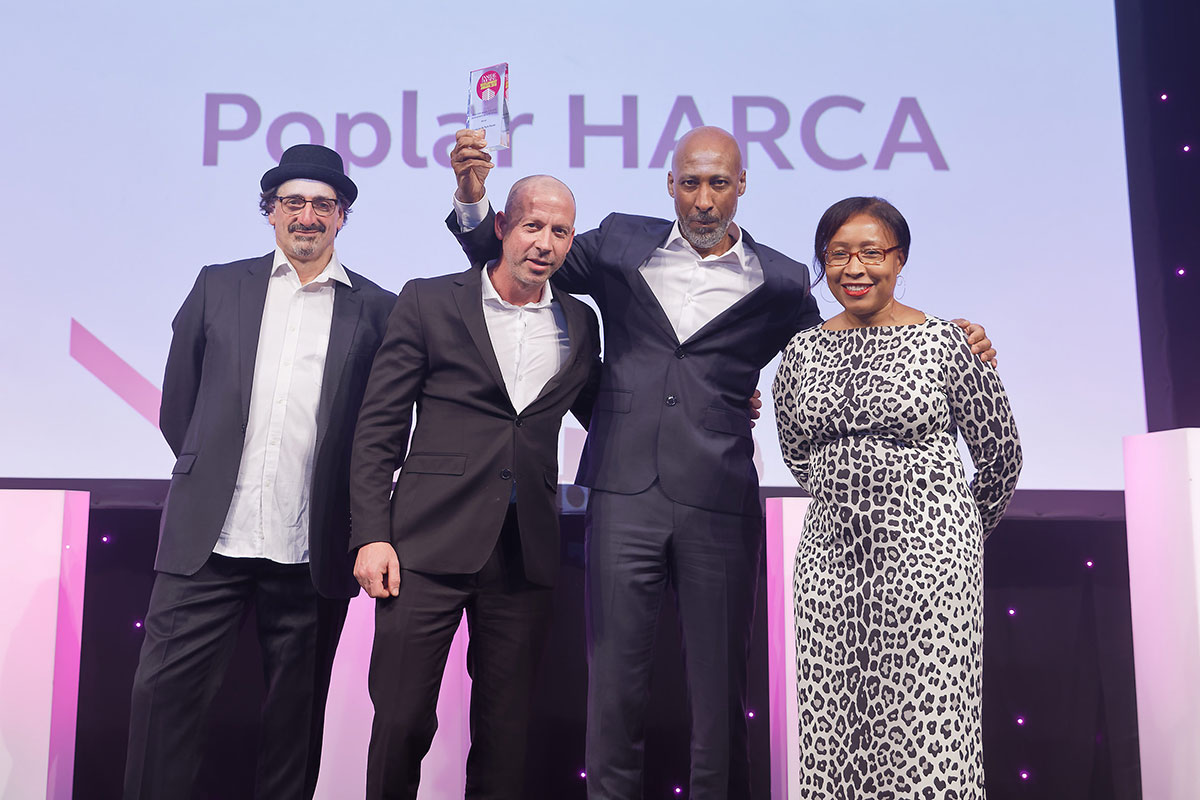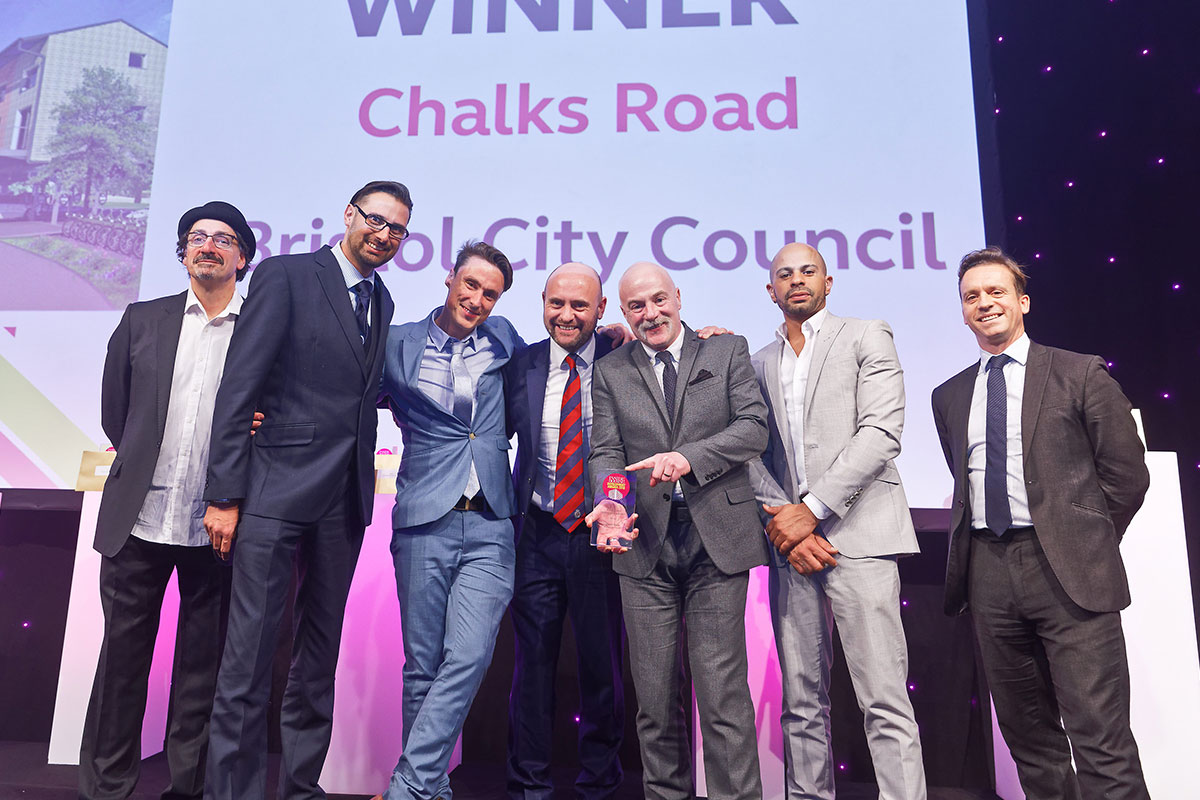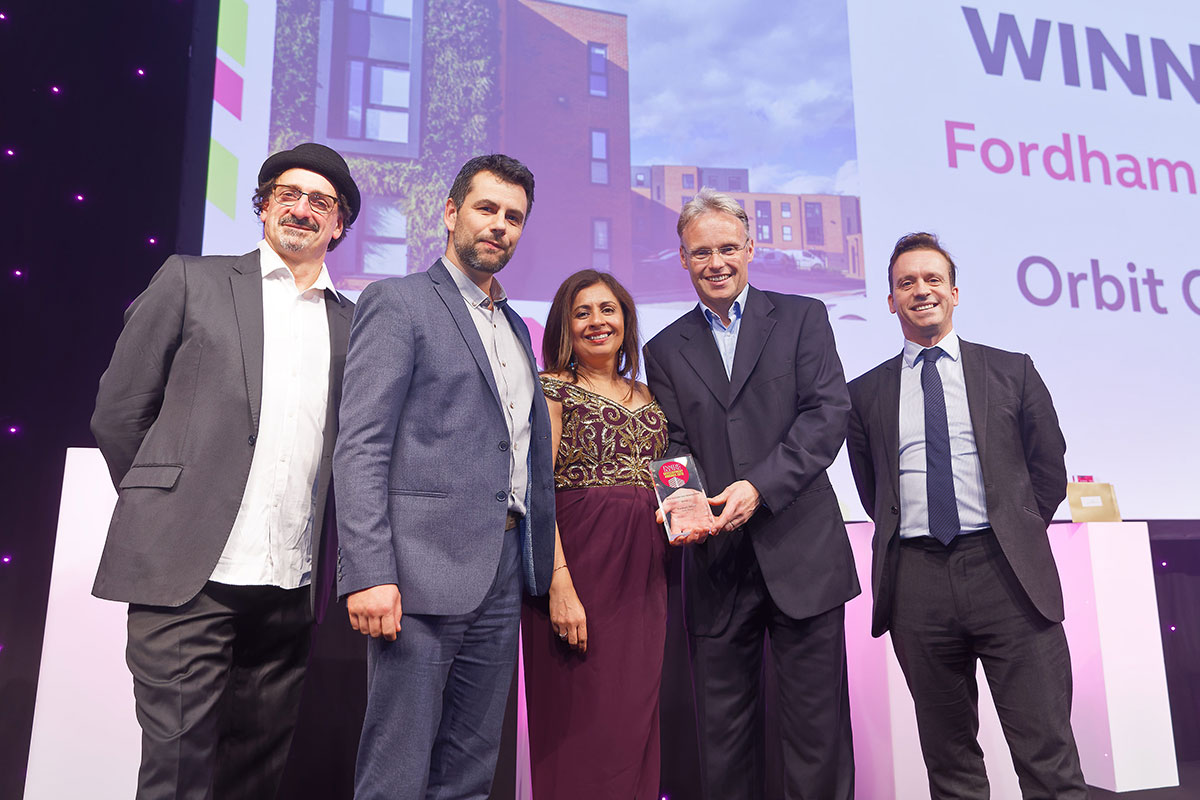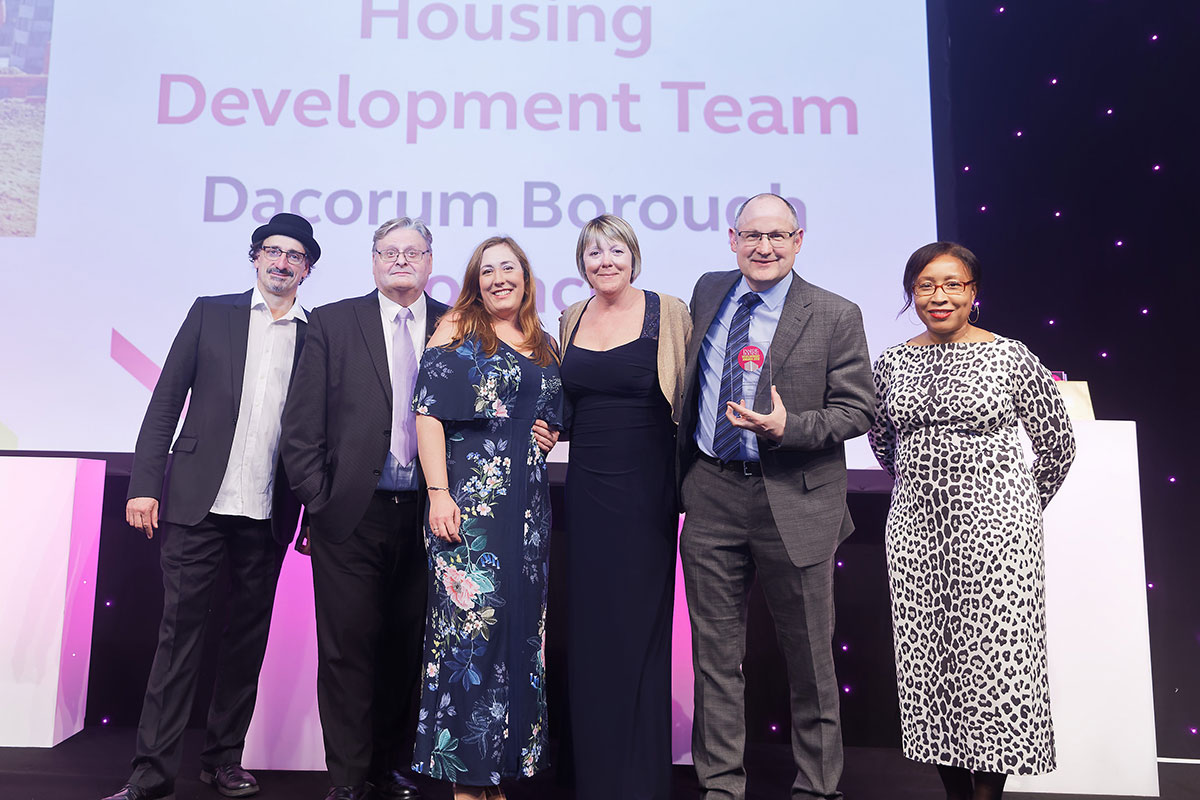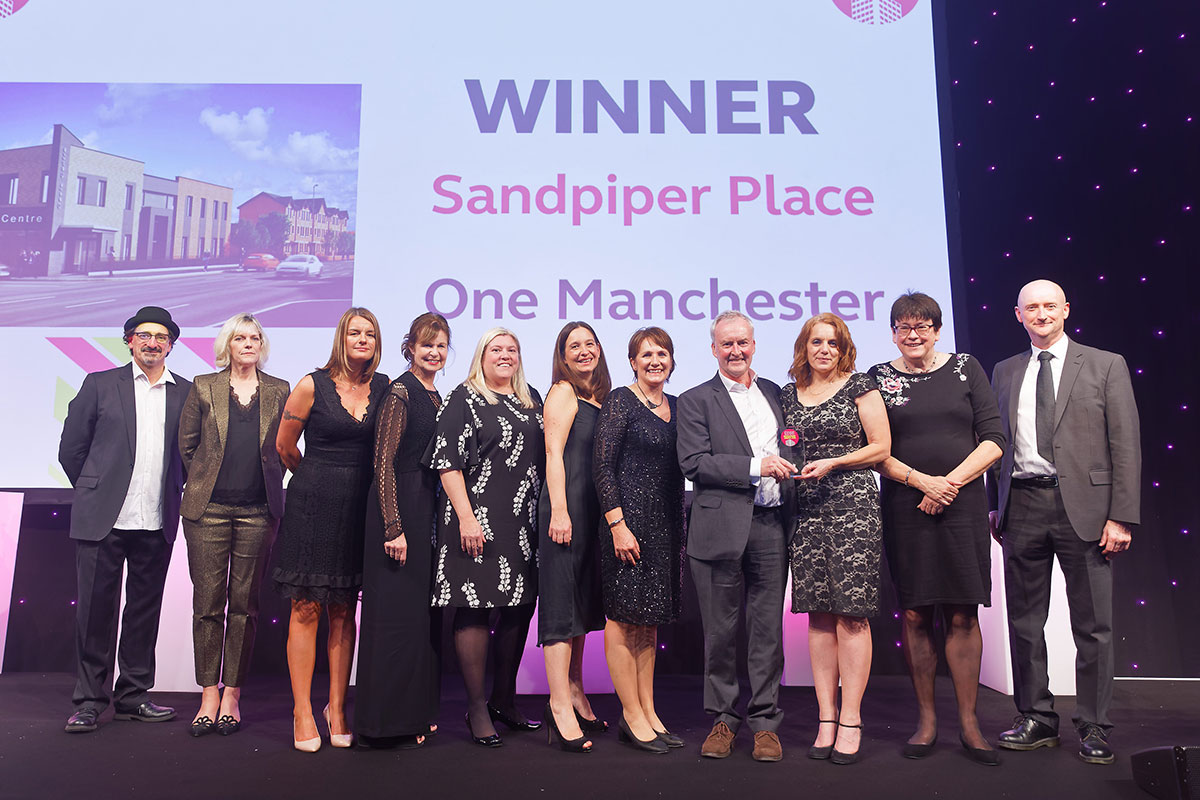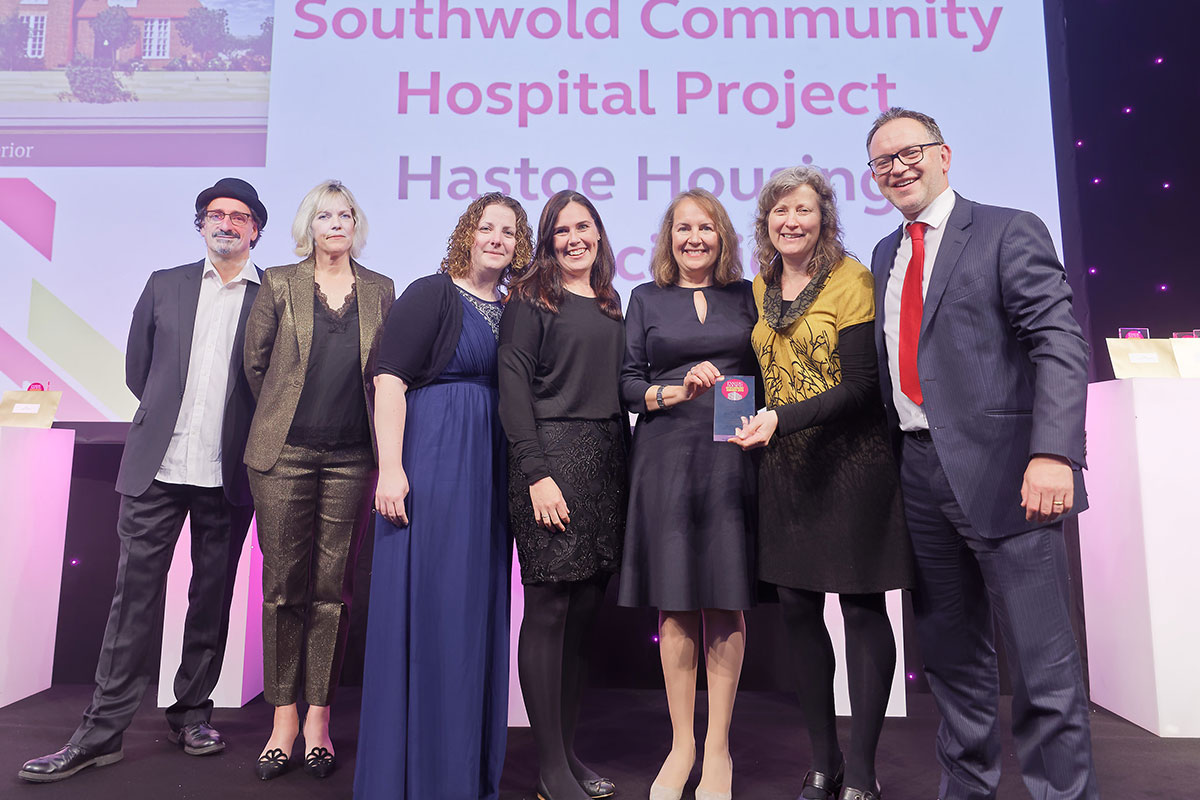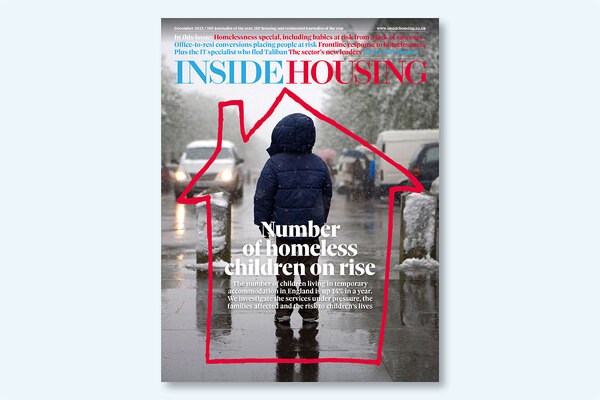You are viewing 1 of your 1 free articles
Inside Housing Development Awards 2019 – why they won
We reveal more about why this year’s Inside Housing Development Awards winners were successful. Photography by Red Rabbit Productions
The third annual Inside Housing Development Awards were held at the InterContinental O2 Hotel in London.
Martin Hilditch, editor of Inside Housing, welcomed attendees and said: “There has been a welcome focus on the quality of the homes we build in 2019. The standard of entries for this year’s Inside Housing Development Awards has been similarly impressive – and I’m delighted we can help flag learning from some of the best development schemes across the UK.”
Comedian Addy van der Borgh entertained the guests before introducing the shortlisted organisations and presenting the awards.
Headline sponsor:

Introduction
The colour of the government that will guide us through 2020 (and possibly beyond) was not known at the time of writing, but whichever party is in charge, there are some areas of clarity.
First, all the main parties agree that there is a need to build a substantial number of homes. Second, there will be a focus on the quality of the homes we are building. This will pick up on the conversation started by the Building Better, Building Beautiful Commission this year. And with many councils declaring climate emergencies, the sustainability of our stock is likely to come under the microscope.
If the focus is on high-quality housebuilding, then the following pages contain some pointers for the next government. The Inside Housing Development Awards, supported by H+H, shouts about the work of individuals, teams and organisations which are leading the way.
Thanks to all our judges for their time, and to H+H and our sponsors for enabling the awards to take place.
I hope everyone enjoys the supplement and picks up some tips to improve the next generation of homes.
Martin Hilditch, editor, Inside Housing
Best development team (small)
THRIVE HOMES
- This team has helped Thrive Homes go from a standing start to become a serious developer
- Development output has increased massively over the past few years and is set to grow further
- A strong focus on people through recruitment and training, both externally and internally
In 2017, Thrive Homes had big plans to grow, but an almost non-existent development programme. That has now changed significantly. Between 2015 and 2017, Thrive was building 20 to 30 homes a year; now its output is more than 150 homes a year and it plans to keep on growing.
The catalyst for this change was the recruitment of a new internal development team in 2017, who gave the organisation the capacity to grow. The team was instrumental in acquiring a 1,000-unit land bank of future opportunities for rent, sale and shared ownership, developing everything from 10-storey town centre towers to semi-rural housing schemes.
The development team continues to recruit a combination of young talent and experience, and Thrive is committed to investing in all its staff. The organisation has launched a CPD-certified internal development training programme for non‑development staff who want to learn more.
The energy and enthusiasm of Thrive Homes’ development team have been critical to the organisation’s success in meeting its growth targets, as well as in building its reputation as a trusted developer.
The judges said
“A strong standing start, a bold strategy of land acquisition, and a broad range of products across tenures and locations. A strong people story, from recruiting new employees to internal development of staff skills”
This category was judged by
Tom Barclay, group director of property and development, Wheatley
Rebecca Larkin, senior economist, Construction Products Association
Best older people's housing development (50+ homes)
HULL CITY COUNCIL
Newbridge Village
- Integrated housing and care for older people that helps residents live healthier, longer lives
- This development of 82 bungalows and care centre is the largest of its kind in the country
- Newbridge Village is a case study in investing in health and housing for the long term
Newbridge Village demonstrates Hull City Council’s commitment to facing the challenges of an ageing population and placing care facilities where they are needed most.
Like many other cities, Hull has a lack of suitable housing for older people. Bungalows account for less than 1% of all new builds in the city and the number of affordable bungalows has continued to decline.
As a result, the council is adapting an increasing number of council houses – some 20% of its 24,000 homes have at least one adaptation – which is costing it more than £1.5m a year.
Newbridge Village is a scheme of 82 affordable bungalows with an integrated care centre, built on a brownfield urban regeneration site. The bungalows are designed to meet the needs of older people, while the centre supports patients with health problems associated with older age and works to prevent people going into hospital unnecessarily.
The scheme is already having a positive impact. The residents’ quality of life is improving, and the council’s investment is already saving money on healthcare and housing services. This is a community that supports its residents to live healthier, longer and independently.
The judges said
“This was a standout entry with a bold commitment to meet the local demands of an ageing population, using large upfront investment to generate longer-term savings on healthcare and housing”
This category was judged by
Tom Barclay, group director of property and development, Wheatley
Rebecca Larkin, senior economist, Construction Products Association
Best regeneration project (70+ homes)
ORBIT GROUP
Erith Park
- Orbit has transformed a blighted former council estate into a desirable, mixed-tenure scheme
- The fall in crime and increase in house prices are testament to the development’s success
- Orbit took a risk by developing in a low-value area – but it has paid off handsomely
The Larner Road Estate in Bexley, south-east London, was a former council estate that had become blighted by crime and anti-social behaviour. Today – renamed Erith Park – it has been transformed by Orbit Group into a thriving and sought-after mixed-tenure neighbourhood.
Working with local residents from the get-go and throughout the process, Orbit demolished the old tower blocks and built a brand new neighbourhood from the ground up, turning a neglected place of last resort into a safer, more welcoming, high-quality development of 587 homes for rent, shared ownership and market sale – on time and on budget.
The scheme’s success is clear in many ways. Not a single burglary has been reported in a neighbourhood once notorious for break-ins, while the crime rate has fallen to 20% of the rate in the surrounding wards. Meanwhile, for-sale housing has risen in value 40%, compared with 25% over the same period in the local market – underscoring the desirability of this new neighbourhood.
Erith Park is a landmark regeneration project that has transformed a mono-tenure estate with little pride into a truly desirable neighbourhood – and shows what can be achieved through vision, determination and collaboration.
The judges said
“The risk of developing in a low-value area has paid off, with significantly improved outcomes in terms of design, desirability and the public realm”
Highly commended
Newfield Road, North Kesteven District Council
This category was judged by
Tom Barclay, group director of property and development, Wheatley
Rebecca Larkin, senior economist, Construction Products Association
Best shared ownership development (rural or suburban)
MARTIN ARNOLD
Woodfield Park
- A development that meets an identified local need for high-quality affordable housing
- Project partners overcame several challenges, including opposition from local planners
- The developers took an innovative approach and the project came in significantly under budget
Woodfield Park is a new build development in Emsworth, Hampshire, built on an infill site and comprising 17 high-quality affordable homes – 10 apartments and seven family houses, with a tenure mix of 47% shared ownership and 53% affordable rent.
The scheme’s genesis was not easy. Developer Hyde Group had identified a lack of affordable housing in the area and affordability was its primary focus. But obtaining planning permission proved to be a huge challenge.
It was decided early on in the project that it was feasible to increase the number of properties from the 12 initially proposed to 17, but local planners were generally opposed to increasing the dwelling density on an infill site that also had to blend in with the local street vernacular. They would only consider a scheme of outstanding architectural merit – and that is what was delivered.
But construction came with its own challenges. The site was not within easy reach of many contractors, and Martin Arnold and Hyde proceeded using an innovative approach to construction management procurement, with Hyde effectively treating it as a self-build project. In doing so, it was able to use local contractors and even delivered the project 14% under budget.
The judges said
“This 100% affordable development overcame clear challenges, not least viability issues and planning opposition that required the scheme to be of outstanding architectural merit”
This category was judged by
Tom Barclay, group director of property and development, Wheatley
Rebecca Larkin, senior economist, Construction Products Association
Best shared ownership development (urban)
ROTHERHAM COUNCIL
The Bellows
- This council-built site is a successful response to the lack of affordable homes for sale in the borough
- Rotherham Council used CPO powers to enable redevelopment of a challenging site
- There is already evidence that the scheme is helping a once-unloved area to flourish again
Rotherham, in South Yorkshire, needs more low-cost homeownership options, due to the large number of first-time buyers priced out of the market and older homeowners wishing to downsize. This development in the north of the borough is part of Rotherham Metropolitan Borough Council’s response.
The Bellows – the name reflects the area’s history as a centre for ceramics and pottery – is the council’s first major shared ownership scheme. It delivers 30 shared ownership houses, including two wheelchair-accessible homes, alongside 28 others for council rent, in the heart of a popular, well-connected community.
The scheme is built on the site of a 1970s shopping arcade that had fallen into disrepair. The council used compulsory purchase orders (CPOs) to buy and demolish the empty shops, as well as a neighbouring multistorey car park that had become a magnet for anti-social behaviour.
The site’s topography also posed a challenge when designing the new homes. However, the council embraced this, incorporating it into the scheme’s layout.
Following a show home opening event in July, there has been significant interest in the shared ownership homes, according to the council. The uptake of these homes will help inform the level of shared ownership needed in other council developments across the borough.
The judges said
“We were impressed with how the council used compulsory purchase order powers to acquire an undesirable site and turn it around, incorporating its challenging topography into the design”
This category was judged by
Tom Barclay, group director of property and development, Wheatley
Rebecca Larkin, senior economist, Construction Products Association
Sponsored by

Best affordable housing development (urban)
SHETTLESTON HOUSING ASSOCIATION
Cunningham House
- This scheme includes Glasgow’s first social housing built to Passivhaus standards
- It incorporates a much-loved old church, which has been refurbished sympathetically
- Thermal efficiency and the use of technology will save residents considerable amounts of money
The residents of Shettleston Housing Association’s Cunningham House scheme will be living in some of the most energy-efficient homes built in Scotland to date. The developers have used Passivhaus and solar technology, as well as fuel-efficient heating and telecoms infrastructure, which should provide residents with an anticipated annual saving of up to £300 on their utility bills.
This project saw the conversion of Carntyne Old Church in Glasgow into 14 amenity flats and one family home. It integrates Glasgow’s first Passivhaus build specifically for social housing in five properties within a new build tower block that sits adjacent to the church.
This project is one that the community in Shettleston holds dear, as many of those who live in the surrounding area have been christened or were married in the church. To preserve the church the developers had to use a bespoke approach, due to the mix of the old building and the new modern extension.
This resulted in the need to combine traditional skills with cutting-edge Passivhaus knowledge. The former included stone masonry works, the refurbishment of stained glass windows, the repair of lead work, the use of natural slating and bench hand carpentry, all of which are clearly visible on site.
The judges said
“This amazing and unique scheme blends a 19th century church refurbishment with 21st century Passivhaus new build. It has saved a local landmark while benefiting the local community”
This category was judged by
Sheron Carter, chief executive, Habinteg
Sue Manns, vice-president, Royal Town Planning Institute
Sponsored by

Best affordable housing development (in construction)
ARCHIO
Community land trust
- This scheme is the first purpose-built community land trust (CLT) project in London
- The design was chosen by the local community, which has been involved throughout the project
- As a CLT scheme, these homes will be 100% affordable, with the prices linked to local wages
These 11 affordable homes built for the London Community Land Trust (CLT) in Lewisham, south-east London, are the result of a unique local competition.
The site for these homes was gifted by Lewisham Council after a two-year campaign by community organiser Lewisham Citizens. Residents and members of the community were asked to select their favourite design at a public workshop and Archio’s was the winner.
The community have been engaged in the design of the new homes throughout. Lewisham Citizens has provided a critical link to the community during the design process, which has helped the developers to build and maintain connections with local people. The process has also provided a forum in which residents have been able to come together and get to know each other better.
The project, which is the first purpose-built CLT project in London, will be 100% affordable, with each of the homes sold at a price linked to local wages. This means that one-bedroom homes will cost £192,000, and two-bedroom homes will cost £244,000 – less than half the market price for properties of these sizes in the area.
The judges said
“This scheme stood out for its affordability, which prices the homes in accordance with local wages. It has a strong link with people and place, and stood out for its engagement with the local community”
This category was judged by
Sheron Carter, chief executive, Habinteg
Sue Manns, vice-president, Royal Town Planning Institute
Best development (50-100 homes)
METROPOLITAN WORKSHOP
Mapleton Crescent
- A strong design that anchors the scheme appropriately in its surroundings
- The developers took an innovative approach to what was considered an ‘undevelopable’ site
- Cost and construction times were reduced significantly by using a modular approach
Mapleton Crescent in the centre of Wandsworth, south-west London, is the tallest private for-sale offsite modular residential tower in Europe.
Designed for affordable housing developer Pocket Living, the 27-storey tower includes 89 homes – a mixture of 60% affordable and 40% market value. It includes a rich variety of shared amenity space for residents, with rooftop gardens, shared balconies and a riverside terrace, which will help build a community and encourage social interaction in the scheme.
The development occupies a tight triangular site backing onto the River Wandle and Southside Shopping Centre. This site had remained undeveloped for decades, as building on it using traditional construction methods is challenging – any development needed to take into account not only the river, but a substation and a storm-water drain, too.
But a combination of in-situ concrete structure and volumetric offsite prefabrication unlocked the site’s potential and delivered cost and time advantages. Contractor Donban’s modular solution cost 15% less and was delivered four months quicker than traditional construction.
Mapleton Crescent’s design overcomes and is inspired by the constraints of what was considered an ‘undevelopable’ site. It has generated a unified, powerful character for the scheme and created a socially and economically beneficial new landmark.
The judges said
“This was an excellent approach to a difficult site, using strong, good-quality design that anchors it appropriately in its surroundings. It is a landmark development, employing good use of modular construction”
This category was judged by
Sheron Carter, chief executive, Habinteg
Sue Manns, vice-president, Royal Town Planning Institute
Best regeneration project (up to 70 homes)
CHILD GRADDON LEWIS
Dalston Lane Terrace
- A great example of good design bringing a derelict terrace back to life
- The designers’ phased approach encouraged local businesses to stay
- The new homes preserve the area’s character while improving the streetscape
Dalston Lane Terrace is a conservation-led, mixed-use regeneration project in Hackney, east London. It brings a severely dilapidated late-Georgian to Victorian period terrace back to life, creating a coherent piece of architecture that significantly improves the townscape. Designed by Child Graddon Lewis (CGL) for Murphy Homes, it sympathetically blends heritage with contemporary architecture to create 44 new homes and 1,000 square metres of retail space.
The buildings were inherited in a state of significant disrepair, and the original houses varied in height, design and detailing. The shopfronts were also in extremely poor condition and Hackney London Borough Council wanted to keep the existing local retailers – music shops that were also local institutions – and complement them with new tenants that could provide local neighbourhood amenities.
For this to happen, the scheme was built in two phases, ensuring that the retailers could be temporarily re-homed and kept open during the build. By retaining the freehold and managing the commercial leaseholds, Hackney can now beneficially offer competitively priced rents and determine the retailers it wants to attract.
Working in collaboration with Murphy, CGL’s design is a demonstration of stitching the local historic fabric into a new development, preserving the visual ancestry and spirit of a place that will now thrive once again.
The judges said
“This scheme adds value to the wider town centre regeneration. It complements the conservation area really well, with good rhythm and separation and a wonderful uplift of the streetscape”
This category was judged by
Sheron Carter, chief executive, Habinteg
Sue Manns, vice-president, Royal Town Planning Institute
Best affordable housing development (rural or suburban)
DACORUM BOROUGH COUNCIL
Kylna Court
- The council identified a need for social rent and made sure it was delivered
- The scheme is designed to a very high environmental specification and minimises energy use
- The council worked with the community, adding social value as well as new housing
Dacorum Borough Council’s flagship scheme Kylna Court provides 79 flats for social rent in the heart of the Maylands area in Hemel Hempstead. This was a key location and a highly important project, due to the council’s need to construct 300 new affordable homes between 2013-2020.
The development presented several challenges from the beginning, and there was pressure on the whole team including the client for this project to be a success. Underground investigations found weathered chalk 16 metres below the surface, which required an innovative design solution for the foundations and concrete frame.
Kylna Court was also designed and built to a highly energy-efficient specification. It has been given an environmental impact rating score of 85 out of 100, based on the amount of CO2 that it produces, with Kylna Court residences creating approximately 1.2 tonnes less emissions each year than the average household.
The ground floor contains a new managed business suite providing flexible units for start-up organisations that is owned and run by the council. It is a central and local hub for the Maylands Business Park.
The judges said
“A local authority-led mixed-use development providing 79 social rented homes in an area of high demand and cost. Well designed with good insulation standards, it provides wider added social value”
This category was judged by
Michelle Thomas, director of development and regeneration, Trivallis
John Williamson, managing director, Barratt Partnerships
Best development (up to 50 homes)
CHILD GRADDON LEWIS
- The scheme blends heritage with contemporary architecture
- A well thought-out regeneration project that preserves and enhances the area’s character
- Careful planning has enabled existing businesses to keep trading and new ones to open
Situated in Hackney, east London, Dalston Lane Terrace is a conservation-led, mixed-use regeneration project designed by Child Graddon Lewis (CGL) for Murphy Homes. It sympathetically blends heritage with contemporary architecture to create 44 new homes and 1,000 square metres of retail space. The design brings a severely dilapidated late-Georgian to Victorian period terrace back to life, creating a coherent piece of architecture that significantly improves the townscape.
CGL was appointed in 2011 to transform and breathe life back into the terrace. The practice’s principal objective was clear – restore, repair and enhance the buildings through conservation-led sustainable development.
CGL has created a design that unifies the terrace while retaining its asymmetric ad-hoc character. The historic front facade is married with a contemporary elevation to the south, creating a distinctive modern frontage for residential entrances while simultaneously allowing for generous windows and balconies.
This area has undergone rapid change in the past decade as a result of a new transport hub at Dalston Junction and the major town centre regeneration project. The development at Dalston Lane Terrace complements this, further attracting young professionals and families to this well-connected location, with a mixture of outstanding triplexes, duplexes and flats.
The judges said
“A well-designed, thoughtful and complex regeneration project that has retained existing businesses and attracted new ones into the ground-floor retail spaces. A sympathetic and creative use of these historic buildings”
This category was judged by
Michelle Thomas, director of development and regeneration, Trivallis
John Williamson, managing director, Barratt Partnerships
Sponsored by

Best development (100+ homes)
POPLAR HARCA
Bow Garden Square
- This was a complex and challenging build with a tight timescale for delivery
- As well as housing, the scheme incorporates a new mosque, school, park and community hall
- All these amenities share the same space in what is a stunningly efficient use of the land
At Bow Garden Square, Poplar HARCA – in partnership with Telford Homes and the London Borough of Tower Hamlets – has transformed an east London estate into a superb mixed-use development of 109 high-quality mixed-tenure homes. The homes sit alongside a new state-of-the-art primary and nursery school, sports/community hall, public park and playground, and mosque.
Demolition of the previous Burdett Estate began in 2012, with construction taking place in 11 phases over four years. This underlines the complex challenges associated with this build, not least the site’s enclosed nature. The build programme was further restricted because demolition could not take place during school breaks, lunchtimes and PE classes. Neither could construction overrun – it had to be complete for the new influx of pupils at the start of the September term.
The completed development brings new and existing residents of Bow together through much-needed new homes and shared facilities, and has created a genuine sense of community. Since the development launched in late March 2018, every home has been sold, which is an exceptional performance in the challenging London market.
Today, Bow Garden Square has totally transformed the area. The sound of children playing is complemented by an influx of new residents, who are housed in architecturally striking new buildings.
The judges said
“This is a complex, mixed-tenure development showcasing the integration of a new nursery and primary school, mosque, pocket park and playground, and sports/community hall”
Highly commended
North Stoneham Park, VIVID
This category was judged by
Michelle Thomas, director of development and regeneration, Trivallis
John Williamson, managing director, Barratt Partnerships
Best development team (large)
THE WREKIN HOUSING GROUP
- Haybridge Hall is a sympathetic redevelopment of a site rich in local heritage
- Faced with the insolvency of the project’s main contractor, Wrekin took the job in house
- In doing so, the team not only learned new skills but delivered savings of 15% on the scheme
When the going gets tough, this team gets going. Over the past year, their main achievement has been the delivery of a stalled development scheme – Haybridge Hall and Hall Gardens in Telford, Shropshire.
This was a very problematic site that included an old Victorian hall built in 1860 and some unpopular, tired flats built in the 1960s that required substantial investment. Working with English Heritage and in consultation with customers and the community, Wrekin tendered the work to retain the facade of the old house, demolish the flats, and build a scheme of 10 flats and 12 bungalows.
The deal was done in March 2017. However, once demolitions had been completed and the works on the bungalows were substantially under way, the contractor declared its insolvency and abandoned the site.
The team responded by transforming from client into contractor, delivering a much-needed quality site of affordable bungalows for older people to Lifetime Homes Standards, while enabling a heritage regeneration site to proceed as a viable scheme. In doing it themselves, the team discovered skills they didn’t know they had, as well as skills in other teams, and even saved 15% on the scheme’s costs.
The judges said
“We liked the fact that the submission was a very personal one and reflected the commitment of the entire team to working together to achieve the best outcome”
This category was judged by
Michelle Thomas, director of development and regeneration, Trivallis
John Williamson, managing director, Barratt Partnerships
Best regeneration project (in construction)
PLUS DANE HOUSING
Welsh Streets
- Plus Dane is delivering in an area that has suffered several failed regeneration attempts
- A 100% affordable redevelopment in a deprived part of Liverpool
- The developer has worked with residents passionate about retaining the area’s Victorian heritage
Welsh Streets in Toxteth, Liverpool, has faced many difficult years, as regeneration plans have failed to come to fruition. It has suffered years of uncertainty and decline due to low-demand, poor housing.
But in 2017, Plus Dane Housing, Liverpool City Council and Homes England began a £17m regeneration project in Welsh Streets. The end result will transform 127 terraced properties into 99 modern, contemporary, 100% affordable homes, and turn the neighbourhood into a place where people want to live and stay.
Residents have campaigned for years to retain their homes and they have always been at the heart of the project. Although it has been necessary to decant tenants during the work, they have been promised they can return if they want to at the same rent. The scheme is also attracting new residents who are benefiting from the option of shared ownership.
Meanwhile, at the heart of the area is a community centre Plus Dane has renovated, transforming it into a ‘Wellbeing Hub’, open to anyone, offering one-to-one employment support services, a community market and volunteer programmes.
The judges said
“This regeneration project represents the long-term commitment of residents, Liverpool City Council and Plus Dane to retain these much-valued and loved homes, rather than using demolition and new build”
This category was judged by
Michelle Thomas, director of development and regeneration, Trivallis
John Williamson, managing director, Barratt Partnerships
Best approach to modular construction
BRISTOL CITY COUNCIL
Chalks Road
- An innovative, low-cost, high-quality housing solution for areas constrained by space
- The scheme has been designed for young people working towards independent living
- An affordable, low-carbon development that could be rolled out in similar areas across the country
In July this year, permission was granted for a scheme in Bristol that will offer something truly innovative. The project – a collaboration between Bristol Housing Festival, ZEDpods, a Bristol-based housing association, the YMCA, Bristol & Bath Regional Capital, and Bristol City Council – will see the construction of 11 ZEDpods at Chalks Road public car park.
ZEDpods are a new concept in high-quality, rapid-build, modular, low-energy homes that can use air rights above existing land in city centres. These are low-rent, but high-quality homes with aspirational design and build quality, and their low running costs enhance their affordability.
The aim has been to create a non-institutional environment for young people making their first steps into independent living – supported housing without the support workers, in which they develop interdependence rather than dependence. The development of a community, as opposed to a terrace of houses, gives the young residents their much-aspired-for ‘own front door’, but not in isolation.
When completed, the units will be made available for young people nominated by the YMCA who are on incomes below local average earnings.
The judges said
“This is a compelling idea. It’s an innovative model that provides affordable and low carbon housing, and has the potential to be rolled out in numerous areas of the country”
Highly commended
Gateshead Innovation Village, Home Group and Ilke Homes
This category was judged by
Mark Woodrow, managing director, Packaged Living
Martin Hilditch, editor, Inside Housing
Best build for rent development
ORBIT GROUP
Fordham House
- A stylish, popular scheme that gives priority to local key workers
- Technology is used to enhance the lives of residents
- It has a big environmental focus in its physical aspects and design
The 82 one and two-bedroom apartments at Fordham House in the centre of Stratford-upon-Avon are Orbit’s first properties delivered in the organisation’s wider plan to build 1,500 private rented homes by 2027.
Built on the site of a redundant office building fronting a busy main road, the scheme has convenience, cutting-edge technology and easy maintenance built into every detail. Digital self-service is at the heart of the development’s concept – information for new residents, door entry, account management, messaging and fault-reporting are all available through a mobile app developed for Orbit’s private renters. The app also features a suite of YouTube videos that explain how every aspect of the scheme works; these can be quickly added to or updated in response to feedback from customers.
The lettings strategy agreed as part of the scheme’s planning approval gives priority to people working in key public services or to local businesses supporting the town’s principal industry: tourism. And with 80% of residents working in the town and most able to walk or cycle to work, this is a green development, too.
Orbit has built a stylish, popular scheme, which it says will now serve as the template for the organisation’s future private rented developments.
The judges said
“We loved this scheme because it gave priority to key workers and the developer has really thought deeply about how people live and what they want from their living environment”
This category was judged by
Mark Woodrow, managing director, Packaged Living
Martin Hilditch, editor, Inside Housing
Best council/ALMO development team
DACORUM BOROUGH COUNCIL
- From a standing start in 2015, the team has progressed at a remarkable pace
- Dacorum has comfortably outperformed its own targets and continues to aim higher
- The well-designed, high-quality social housing delivered meets a clear local need
Following legislation changes in 2015, Dacorum Borough Council embraced the opportunity to build the first new council homes in the borough for nearly 40 years – including the council’s flagship Kylna Court scheme, which has won another of this year’s Inside Housing Development Awards. It established a dedicated new homes development team and set ambitious targets to provide new homes for social rent.
The council’s initial aim was to build 300 homes by 2020. However, the team’s determination, dedication and excellent relationships forged with contractors ensured that they surpassed this well ahead of their target date.
In the two years to May this year, the team delivered 210 units across seven sites and has a further 103 units under construction at three further sites; it now plans to build another 300 units by 2023.
The team’s enthusiasm, local knowledge and passion have enabled the council to provide well-designed, affordable council housing for local families, while also building sustainable communities by future-proofing homes to meet the needs of an ageing population, as well as those needing disabled adaptations.
The judges said
“Dacorum has delivered many new homes well ahead of its target date – and is a great example of how a small team can make a big difference”
This category was judged by
Mark Woodrow, managing director, Packaged Living
Martin Hilditch, editor, Inside Housing
Best general partnership
GREAT PLACES HOUSING GROUP
Foxhall Village
- This partnership has transformed a derelict site, creating a vibrant urban community
- The scheme has delivered mixed-tenure housing and much-needed green areas in a densely populated area
- It is a great example of how productive collaboration can catalyse regeneration where it is most needed
Not many partnerships can claim to have transformed such a large derelict site in the heart of a seaside town. But the Foxhall Village partnership has been through a journey over the past eight years to deliver a sustainable new neighbourhood in central Blackpool with a diverse range of housing tenures and vibrant street scenes, enabling new residents to invest in their futures.
Foxhall Village is a £50m scheme and one of the most important catalysts in the town’s ongoing regeneration. Delivering 410 homes on a 7.7-hectare site, it is a contemporary and vibrant urban community located in the town centre, with excellent access to the seafront and the surrounding neighbourhood, and creates much-needed green spaces.
But this vision would not have been possible without the formation of a strong partnership, which has blossomed and grown since its inception in 2011. The project is overseen by a steering group and board that has maintained consistent input and commitment to delivery.
With Blackpool Council as the driving force, all partners were involved in each other’s selection and have collaborated on the full range of development challenges. With innovation at its core, the scheme has delivered a mixed-tenure solution in a deprived neighbourhood where no comparable scale of development has taken place for many decades.
The judges said
“This partnership has acted as a catalyst for regeneration that has had a huge impact on the local area, transforming a neighbourhood where no comparable development has taken place for many decades”
Highly commended
Bredbury Curve, Stockport Homes Group
This category was judged by
Mark Woodrow, managing director, Packaged Living
Martin Hilditch, editor, Inside Housing
Best partnership: council or NHS
ONE MANCHESTER
Sandpiper Place
- Displays an exemplary approach to partnership working over an extended period of time
- Partners collaborated to deliver funding and ensure the proposal met everyone’s requirements
- Unlocked social capital on a formerly derelict site, enabling wider social participation
The charity The Oasis Centre provides help, emergency provision, education and employment support to vulnerable residents of Gorton, Manchester. The partnership has managed to offer 26 affordable family homes and enable the charity to deliver improved and expanded services from a comfortable and attractive new centre in Gorton.
Everything about this partnership programme has brought trust, hope and aspiration to a struggling community. It has restored derelict land and provided much-needed housing, offering Rent to Buy to a community struggling to get on the housing ladder. It has also given a much-loved community project the opportunity to expand, develop and thrive.
What makes this partnership a great model is seeing a small charity, large housing provider and a city council work together to restore local land and lives, in a project that will have far-reaching benefits for generations to come.
Victoria Armstrong, chief executive of The Oasis Centre, says: “The building project between Oasis, One Manchester and Manchester City Council has restored derelict land, created new homes and provided much-needed support for thousands of people. It’s a fantastic partnership model that could bring hope to other disadvantaged communities around the UK. It has been a privilege to be part of such a great partnership.”
The judges said
“We were impressed with this bid by One Manchester. The partnership it forged with the local charity, The Oasis Centre, offers more than just the 26 new affordable housing units in Gorton”
This category was judged by
Ellen Vernon, programme director, One Public Estate, LGA
Jeremy Porteus, chief executive, Housing LIN
Best partnership: rural or community
HASTOE HOUSING ASSOCIATION
Southwold Community Hospital Project
- This development has turned the disaster of a hospital closure into a new community benefit
- The partnership at the heart of this scheme has been instrumental in getting it off the ground
- Much-needed affordable housing for local people in an area where they are priced out of the market
Rural housing specialist Hastoe is partnering with community benefit society, SouthGen, to regenerate the East Suffolk town of Southwold’s disused community hospital, turning it into nine affordable new homes and community facilities, including a library, nursery, cafe and shared working spaces.
With more than 60% of its housing now second homes and holiday lets, the once-bustling market town has become a shadow of its former self. Housing is expensive and the local population is ageing rapidly as young people, unable to buy or rent a home, have been pushed out.
The closure of the historic Southwold Community Hospital in 2015 was another blow for the town. Fearing the site would be demolished and redeveloped into more second homes, the local community started a campaign to save the building, spearheaded by SouthGen. Hastoe will develop and manage the new homes, while SouthGen has raised almost £500,000 to fund the community facilities.
When completed in 2021, the development will offer four homes for rent and five for shared ownership, helping first-time buyers onto the housing ladder. All nine will be prioritised for people with a local connection.
Southwold is the first community in the country to have bought back its community hospital for continued community use. This is a unique development that would not have been possible without each of the partner organisations’ involvement.
The judges said
“Community uses sit at the heart of the vision for this scheme and we felt this was an excellent example of how public bodies can work in partnership with communities to meet local needs”
Highly commended
St Bernard’s Church, Onward
This category was judged by
Ellen Vernon, programme director, One Public Estate, LGA
Jeremy Porteus, chief executive, Housing LIN
Market sale development of the year
CHILD GRADDON LEWIS
Warriner Gardens
- This is a modern and sympathetically designed development built on a challenging site
- The design makes excellent use of space and light in the homes, while uplifting the streetscape
- Each house has been built to Code for Sustainable Homes Level 4 and Lifetime Homes Standards
Warriner Gardens in Battersea, south-west London, is a modern interpretation of the humble terraced house, comprising nine exemplary new family homes designed by architects Child Graddon Lewis for Marsa Holdings.
Forming part of the historic Old Imperial Laundry site, the project enhances and improves its streetscape by providing exceptional contemporary homes that respond positively to the local character of the street and the heritage of the wider site. Warriner Gardens is designed as the ultimate in contemporary living for families, formed from a blend of modern architectural forms, playful interlinked spaces and high-quality materials.
The site presented significant challenges to the design team due to its location adjacent to the Battersea Park conservation area. An active neighbourhood group had also endured aggressive planning applications on adjacent sites.
However, the redevelopment of the site presented a rare opportunity to provide a series of new family homes and enhance the quality of the local area. Through extensive communication with planners, consultants and local residents, Warriner Gardens delivers family housing that is directly informed by and respects the scale and materiality of its traditional context, while providing design-focused homes to modern standards.
The judges said
“The design approach stood out for us – a modern interpretation of terraced housing, making excellent use of space and light within the properties and externally enhancing the streetscape”
This category was judged by
Ellen Vernon, programme director, One Public Estate, LGA
Jeremy Porteus, chief executive, Housing LIN
Best older people’s housing development (up to 50 homes)
RCKA
PegasusLife Park House
- A beautifully designed and thought-out scheme on a site that had been derelict for 14 years
- The development is based around social interaction, encouraged by communal and spacious areas
- As well as the residents, this scheme has been built to invite in the local community
Park House is an extra-care development in the centre of Harpenden in Hertfordshire. It occupies what was a challenging infill site that lay derelict for 14 years as no viable solution could be found. This scheme was designed from the outset to foster a sense of community among residents, helping to combat feelings of isolation and loneliness.
Set in a leafy courtyard facing the local park and leisure centre, the scheme offers a collection of sociable homes for people in later life. A ground-floor bistro and restaurant attracts residents and visitors alike, making this a focal point for all in the community.
The three villas, which provide 39 private apartments for older residents, have generous central cores that are about more than just circulation – they are naturally lit and spacious, encouraging people to linger and meet. Almost every home is dual-aspect, with long views across the countryside and down into shared courtyards.
This is a dramatic move away from the traditional model of relocating older people to the periphery of towns – ‘out of sight, out of mind’. Instead, Park House embeds them in the heart of the local community.
The judges said
“This was an outright winner. The development has been inspired by Harpenden’s arts and crafts movement and this is delicately revealed in the interior design, individual apartments and the exterior”
This category was judged by
Ellen Vernon, programme director, One Public Estate, LGA
Jeremy Porteus, chief executive, Housing LIN
Judges
Inside Housing recruited a panel of expert judges from across the housing sector with a wide range of experience to decide the winners of Inside Housing Development Awards 2019.
Tom Barclay
Group director of property and development, Wheatley
Sheron Carter
Chief executive, Habinteg
Fiona Fletcher-Smith
Group development director, L&Q
Martin Hilditch
Editor, Inside Housing
Rebecca Larkin
Senior economist, Construction Products Association
Sue Manns
Vice-president, Royal Town Planning Institute
Michelle Meldrum
Executive lead, Gentoo Homes
Jeremy Porteus
Chief executive, Housing LIN
Michelle Thomas
Director of development and regeneration, Trivallis
Ellen Vernon
Programme director, One Public Estate, LGA
John Williamson
Managing director, Barratt Partnerships
Mark Woodrow
Managing director, Packaged Living


